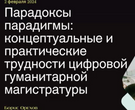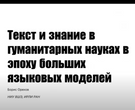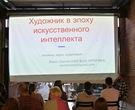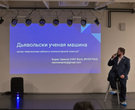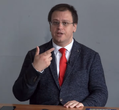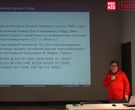- A
- A
- A
- АБB
- АБB
- АБB
- А
- А
- А
- А
- А
- Национальный исследовательский университет «Высшая школа экономики»
- Факультет гуманитарных наук
- Школа лингвистики
- Мероприятия
- Лекции Сильвии Лураги по диахроническому синтаксису хеттского языка
-
Школа
- О школе
- Сотрудники
- Семинары
-
Исследовательские подразделения
-
- Международная лаборатория языковой конвергенции
- Центр «Русский как иностранный»
- Центр цифровых гуманитарных исследований
- Центр языка и мозга
- Лаборатория по формальным моделям в лингвистике
- Лаборатория «Корпусные исследования»
- Лаборатория языков Кавказа
- Лаборатория учебных корпусов
- Лаборатория теоретической и полевой фольклористики
- Лаборатория социогуманитарных исследований Севера и Арктики
-
-
Проекты
-
Проекты сотрудников
-
Проекты студентов и аспирантов
-
Завершённые проекты
- Некомпозициональные конструкции в эритажном русском
- Компьютерные и лингвистические ресурсы для поддержки шугнанского языка
- Лингвоспецифическая разметка китайских текстов в Русско-китайском параллельном корпусе НКРЯ
- Цифровой архив: создание корпуса журнала "Отечественные записки"
- Создание лингвокультурологического подкаста о России для иностранцев «Yellow Blue Bus» (Я люблю вас)
- База данных русских идиом
- Компьютерные и корпусные инструменты для иранистических исследований
- Русский разговорный клуб
- Шугнанские глаголы в типологическом освещении
- Создание академического онлайн-словаря персидского языка
-
- Международное сотрудничество
- Экспедиции
- Ресурсы
- Препринты
- Наша книжная полка
-
Образовательные программы
- Бакалаврская программа «Фундаментальная и компьютерная лингвистика»
- Магистерская программа «Компьютерная лингвистика»
- Магистерская программа «Лингвистическая теория и описание языка»
- Магистерская программа «Русский как иностранный во взаимодействии языков и культур»
- Магистерская программа «Цифровые методы в гуманитарных науках»
- Аспирантская школа по филологическим наукам
Адрес: 105066, г. Москва,
Старая Басманная ул., д. 21/4
Телефон: +7 (495) 772-95-90 доб. 22734
E-mail: ling@hse.ru
Редакторы сайта — Наталья Борисовна Пименова, Татьяна Борисовна Казакова, Максим Олегович Бажуков
- Международная лаборатория языковой конвергенции
- Лаборатория «Корпусные исследования»
- Лаборатория по формальным моделям в лингвистике
- Лаборатория языков Кавказа
- Лаборатория социогуманитарных исследований Севера и Арктики
- Научно-учебная лаборатория учебных корпусов
- Центр «Русский как иностранный»
- Научно-учебные группы
- Каталог проектов по компьютерной лингвистике
- Проекты, поддерживаемые грантами
- Русский язык для всех
- Лингвистический кружок для школьников
- Лингвистика в Центре открытого образования
Школа лингвистики была образована в декабре 2014 года. Сотрудники школы преподают на образовательных программах по теоретической и компьютерной лингвистике в бакалавриате и магистратуре. Лингвистика, которой занимаются в школе, — это не только знание иностранных языков, но прежде всего наука о языке и о способах его моделирования. Научные группы школы занимаются исследованиями в области типологии, социолингвистики и ареальной лингвистики, корпусной лингвистики и лексикографии, древних языков и истории языка. Кроме того, в школе создаются лингвистические технологии и ресурсы: корпуса, обучающие тренажеры, словари и тезаурусы, технологии для электронного представления текстов культурного наследия.
Цифровые гуманитарные исследования. 2025. № 1. С. 60-69.
Daria I., Konstantin Zaitsev, Olga S.
In bk.: CLEF 2025 Working Notes. Vol. 4038. CEUR Workshop Proceedings, 2025.
arxiv.org. Computer Science. Cornell University, 2024

Лекции Сильвии Лураги по диахроническому синтаксису хеттского языка
Сильвия Лураги — профессор университета Павии (Италия), известный типолог, специалист по актантным деривациям и семантическим ролям, совмещающая опыт исследования индоевропейских языков с типологическими интересами и методами. Лекции ориентированы в первую очередь на студентов бакалавриата и магистратуры, но открыты для всех желающих.
Содержание лекций и подготовительное чтение размещены ниже.
Лекции будут проходить в аудитории 502 с 18:00 по 21:00.
Чтобы зарегистрироваться на курс, пожалуйста, пройдите по следующей ссылке.
Посетителям из других организаций регистрация необходима в том числе для того, чтобы попасть в здание; при себе необходимо иметь паспорт.
Как до нас добраться?
Аннотации лекций и список чтения (часть текстов размещена здесь)
Lecture 1. Trends in the development of sentence connectives in Hittite: Evidence from subordination
Silvia Luraghi (University of Pavia)
Abstract
Old Hittite sentence connectives nu, ta and šu display a significantly different distribution when connecting a preposed subordinate clause to the main clause and when connecting two main clauses to their distribution between main clauses. Other distributional restrictions concern ta and šu in all syntactic environments, but do not concern nu. The discourse function of connectives when they occur between main clauses points to partly different roles by which they variously indicate event and/or participant continuity, and contribute to the grounding of information. Ongoing increase in the frequency of P2 clitics also called for the occurrence of connectives as hosts. Lack of distributional restrictions on the occurrence of nu made it multifunctional, and suitable as a host for P2 clitics while preserving at least in part its original discourse function: this brought about the onset of a change by which nu replaced other connectives. The discourse function of connectives is blurred when used to connect a subordinate and a main clause, as subordinate clauses explicitly indicate their relation to the main clause. Due to its multi-functionality, nu also extended more readily to this syntactic environment, in which it developed into a clause boundary marker. Uneven distribution of connectives in different syntactic environments is a consequence of gradualness in actualization of language change.
Lecture 2. From verb to New Event Marker: another look at the Hittite pai- and uwa- constructions
Silvia Luraghi, Università di Pavia
Hittite has two deictic motion verbs, pai- ‘go’, formed with the prefix pe- ‘thiter’, which indicates motion away from the deictic center identified with the speaker, and uwa- ‘come’, formed with the prefix u-‘hither’, which contrariwise indicates motion toward the speaker. Besides functioning as motion verbs, these verbs may occur in contexts in which they do not convey their proper meaning, and do not function as predicate of an independent clause. This is best exemplified by occurrences such as (1), in which clearly no motion is indicated.
- GI[M]-an= ma= za uit ŠEŠ- YA [( m Arnuwandas DINGIR LIM kisat)
when conn ptc come.prt.3sg brother my A.:nom god become.prt.3sg
‘When my brother Arnuwanda (came) became god (=died).’
In (1) the semantic information concerning the event encoded in the sentence is conveyed only by the second verb (the king’s brother died). Syntactically, we have to do with a mono-clausal structure rather than with two asyndetically coordinated clauses, as shown by the fact that P2 clitics precede the motion verb, but have scope on the second verb (in this case, the particle =za which usually accompanies the verb kis- when it means ‘become something’).
This type of construction is traditionally called ‘phraseological’ and has been described in several studies as an instance of verb serialization based on typological parallels, while its diachrony has been discussed in philologically oriented work. Rather than focusing on the development undergone by the two verbs, one can achieve a better understanding by considering this peculiar use as instantiation of a construction, the pai-/uwa- plus agreeing verb construction. This construction has arisen through constructionalization, when the implicature based on the pragmatic inference ‘if one moves and the focus is not on the spatial location to which s/he moves, then it is the mover’s participation in the following event that is focused’ became part of the semantics of the construction. This development led the two verbs to acquire the function of New Event Markers (NEM) in the sense of Heine & Kuteva (2002: 68-69). In construction containing a NEM, an event is perspectivized and highlighted as new: similar developments of deictic motion verbs are known from other genetically unrelated languages. Based on findings concerning the different distribution of pai- and uwa- one can argue that the pai-/uwa-AV construction must be regarded as consisting of two sub-constructions, semantically distinct through the opposite deictic meaning of the two motion verbs. The two verbs have undergone transcategorialization, as shown by their semantics and their syntactic behavior, and still preserve verbal morphology as a manifestation of the “behavior before coding” principle. In addition, their tendency to occur either after a connective and possible clitics or in sentence initial position hosting possible clitics is similar to the position of the modal particle man: this suggests that cliticization would have been a likely further development of the two verbs as NEM. A possible reason for the rise and extension of the pai-/uwa-AV construction after the Old Hittite particle could be the loss of pragmatic force of the particle nu that will be discussed in the first lecture.
Lecture 3. The origin of ergative case markers: the case of Hittite revisited
Silvia Luraghi (University of Pavia)
Abstract
Hittite neuter nouns must take a dedicated -ants/antes form when they occur as the subject of a transitive verb. There is still no consensus on the interpretation of this pattern: while for some scholars -ant- is a derivational suffix that indicates gender motion from neuter to common gender, others hold that -ants is an ergative case marker, and that Hittite features a gender-based system of split ergativity. In this talk, I explore the distribution of -ants nouns in a corpus of chronologically ordered Hittite texts, and show that whereas the suffix started out as derivational in Old Hittite, it became an ergative case ending in New Hittite. I further assess the semantics of the suffix at its derivational stage based on comparison with other -ant- formations, such as possessive adjectives and verbal nouns among others, and show how the various functions of the suffix may have paved the way for its development into an ergative case marker.
Lecture 4. Basic valency orientation and the middle voice in Hittite
Silvia Luraghi (University of Pavia)
Abstract
In this talk, I discuss basic valency orientation in Hittite, based on the typology proposed in Nichols et al. (2004). Verb pairs usually employed for testing basic valency indicate a clearly transitivizing character of this language; a closer scrutiny of intransitive verbs further reveals the existence of a three-fold distinction featuring two intransitive verbs, a basic stative one (or an adjective), and an overtly marked intransitive change-of-state, in addition to a transitive counterpart overtly marked as causative. The high productivity of causative derivation is shown by the fact that morphological causatives are not only derived from stative verbs, but also from telic intransitive, as well as from transitive verbs. In the case of telic intransitive verbs, a minor pattern is also attested, whereby valency alternation is encoded through voice alternation, with intransitive forms inflected in the middle voice and transitive forms in the active. Since neither voice can be considered derived with respect to the other, verbs that display this behavior are indeterminate as to basic valency orientation. In spite of the limited extent to which voice indicates valency alternation, this finding becomes more significant when set into the framework of valency alternation in the early Indo-European languages, and sheds some light (or rises more questions) on the original function of the Hittite and of the Indo-European middle voice, a typologically puzzling category.
Readings
Lecture 1
Mauri C., Coordination, in: S. Luraghi & C. Parodi (eds.) The Bloomsbury Companion to Syntax, London, Bloomsbury, 2013, pp. 292 - 310
Lecture 2
Haspelmath, M. The serial verb construction: Comparative concept and cross-linguistic generalizations. Language and Linguistics 17(3). 291–319
Lecture 3
McGregor, W. B. 2009. Typology of ergativity Language and Linguistics Compass 3(1): 480–508.
Lecture 4
Nichols, J., D. Peterson & J. Barnes. 2004. Transitivizing and detransitivising languages. Linguistic Typology 8.2: 149-211
- О ВЫШКЕ
- Цифры и факты
- Руководство и структура
- Устойчивое развитие в НИУ ВШЭ
- Преподаватели и сотрудники
- Корпуса и общежития
- Закупки
- Обращения граждан в НИУ ВШЭ
- Фонд целевого капитала
- Противодействие коррупции
- Сведения о доходах, расходах, об имуществе и обязательствах имущественного характера
- Сведения об образовательной организации
- Людям с ограниченными возможностями здоровья
- Единая платежная страница
- Работа в Вышке
- ОБРАЗОВАНИЕ
- Лицей
- Довузовская подготовка
- Олимпиады
- Прием в бакалавриат
- Вышка+
- Прием в магистратуру
- Аспирантура
- Дополнительное образование
- Центр развития карьеры
- Бизнес-инкубатор ВШЭ
- Образовательные партнерства
- Обратная связь и взаимодействие с получателями услуг
-
http://www.minobrnauki.gov.ru/
Министерство науки и высшего образования РФ
-
https://edu.gov.ru/
Министерство просвещения РФ
-
http://www.edu.ru
Федеральный портал «Российское образование»
-
https://elearning.hse.ru/mooc
Массовые открытые онлайн-курсы
- © НИУ ВШЭ 1993–2025 Адреса и контакты Условия использования материалов Политика конфиденциальности Карта сайта
- Редактору








